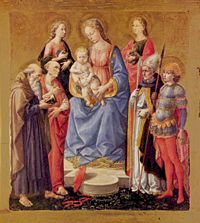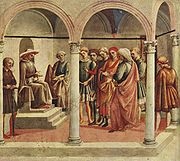
Francesco Pesellino
Encyclopedia

Florence
Florence is the capital city of the Italian region of Tuscany and of the province of Florence. It is the most populous city in Tuscany, with approximately 370,000 inhabitants, expanding to over 1.5 million in the metropolitan area....
) painter. His father was the painter Stefano di Francesco
Stefano di Francesco
Stefano di Francesco was an Italian painter, who probably died young, as he left a five year old son, and was outlived twenty years by his father-in-law, the painter Giuliano Pesello . His son was the painter Francesco Pesellino , the most distinguished of the three...
(died 1427), and his maternal grandfather was the painter Giuliano Pesello
Giuliano Pesello
Giuliano Pesello , whose actual name was Giuliano d'Arrigho, but was known as Pesello, was an Italian painter of the early-Renaissance period, active mainly in Florence. He was a pupil of the painter Andrea del Castagno. Vasari states he painted drawings of animals with skill...
(1367-1446), from whose name the diminutive nickname of "Pesellino" arose. After the death of his father in 1427, the young Francesco Pesellino went to live with his grandfather, Giuliano Pesello, adopting his name. Francesco Pesellino remained in his grandfather’s studio until the latter’s death, when he joined the studio of Filippo Lippi
Filippo Lippi
Fra' Filippo Lippi , also called Lippo Lippi, was an Italian painter of the Italian Quattrocento .-Biography and works:...
(ca.1406-1469). He married in 1442, and probably joined the Florence painters' guild in 1447. In the following years he made a reputation with small, highly finished, works, either religious subjects for predella
Predella
A predella is the platform or step on which an altar stands . In painting, the predella is the painting or sculpture along the frame at the bottom of an altarpiece...
s or private devotions, or secular subjects, often for insetting into furniture or panelling.
Pesellino died in Florence in 1457, at only 35, cutting short a career with great promise. His style "anticipates the developments of later Florentine painters such as Verrocchio
Andrea del Verrocchio
Andrea del Verrocchio , born Andrea di Michele di Francesco de' Cioni, was an Italian sculptor, goldsmith and painter who worked at the court of Lorenzo de' Medici in Florence in the early renaissance. Few paintings are attributed to him with certainty, but a number of important painters were...
and the Pollaiuoli
Pollaiuolo
Pollaiulo is the name of several people:* Brothers Antonio del Pollaiolo and* Piero del Pollaiolo, 15th-Century artists....
".
Works

Santa Croce
Santa Croce is one of the six sestieri of Venice, northern Italy.-Geography:It occupies the north west part of the main islands, and can be divided into two areas: the eastern area being largely mediaeval, and the western - including the main port and the Tronchetto - mostly lying on land reclaimed...
; these are now divided between the Uffizi
Uffizi
The Uffizi Gallery , is a museum in Florence, Italy. It is one of the oldest and most famous art museums of the Western world.-History:...
, Louvre
Louvre
The Musée du Louvre – in English, the Louvre Museum or simply the Louvre – is one of the world's largest museums, the most visited art museum in the world and a historic monument. A central landmark of Paris, it is located on the Right Bank of the Seine in the 1st arrondissement...
, and Bergamo
Bergamo
Bergamo is a town and comune in Lombardy, Italy, about 40 km northeast of Milan. The comune is home to over 120,000 inhabitants. It is served by the Orio al Serio Airport, which also serves the Province of Bergamo, and to a lesser extent the metropolitan area of Milan...
. His only surviving securely documented work, and his only recorded large-scale work, is an altarpiece
Altarpiece
An altarpiece is a picture or relief representing a religious subject and suspended in a frame behind the altar of a church. The altarpiece is often made up of two or more separate panels created using a technique known as panel painting. It is then called a diptych, triptych or polyptych for two,...
with predella
Predella
A predella is the platform or step on which an altar stands . In painting, the predella is the painting or sculpture along the frame at the bottom of an altarpiece...
of the Trinity
Trinity
The Christian doctrine of the Trinity defines God as three divine persons : the Father, the Son , and the Holy Spirit. The three persons are distinct yet coexist in unity, and are co-equal, co-eternal and consubstantial . Put another way, the three persons of the Trinity are of one being...
(National Gallery, London
National Gallery, London
The National Gallery is an art museum on Trafalgar Square, London, United Kingdom. Founded in 1824, it houses a collection of over 2,300 paintings dating from the mid-13th century to 1900. The gallery is an exempt charity, and a non-departmental public body of the Department for Culture, Media...
), which was only half complete at his death, and was finished by Filippo Lippi and his workshop. The main panel, nearly square at over 1.8m in each dimension, shows the Trinity in the Throne of Mercy motif, flanked by four standing saints, and angels. One predella panel is in the Hermitage, St Petersburg. The commission is unusually well documented, to which records of the litigation between Pesellino's widow and his business partner over the money due for the incomplete work can be added, and the records are much cited by art historians. The work was first decided upon in 1455 by the commissioners, the confraternity of priests at Pistoia
Pistoia
Pistoia is a city and comune in the Tuscany region of Italy, the capital of a province of the same name, located about 30 km west and north of Florence and is crossed by the Ombrone Pistoiese, a tributary of the River Arno.-History:...
, and they did not finally receive it until 1460. Drawings for the work also survive. The altarpiece was later cut up into six parts, probably in the eighteenth century, and has now been reassembled, with one section reconstructed, and another on loan from the Royal Collection
Royal Collection
The Royal Collection is the art collection of the British Royal Family. It is property of the monarch as sovereign, but is held in trust for her successors and the nation. It contains over 7,000 paintings, 40,000 watercolours and drawings, and about 150,000 old master prints, as well as historical...
.
A number of other paintings, now lost, hung in prominent positions in the Palazzo Medici and the Medici
Medici
The House of Medici or Famiglia de' Medici was a political dynasty, banking family and later royal house that first began to gather prominence under Cosimo de' Medici in the Republic of Florence during the late 14th century. The family originated in the Mugello region of the Tuscan countryside,...
Casa Vecchia, and at least one work by Pesellino hung in the same room as Paolo Uccello
Paolo Uccello
Paolo Uccello , born Paolo di Dono, was an Italian painter and a mathematician who was notable for his pioneering work on visual perspective in art. Giorgio Vasari in his book Lives of the Artists wrote that Uccello was obsessed by his interest in perspective and would stay up all night in his...
's Battle of San Romano
Battle of San Romano
The Battle of San Romano was fought on June 1st 1432, some 30 miles outside Florence, between the troops of Florence, commanded by Niccolò da Tolentino, and Siena, under Francesco Piccinino. The outcome is generally considered favourable to the Florentines, but in the Sienese chronicles it was...
. Some surviving panel painting
Panel painting
A panel painting is a painting made on a flat panel made of wood, either a single piece, or a number of pieces joined together. Until canvas became the more popular support medium in the 16th century, it was the normal form of support for a painting not on a wall or vellum, which was used for...
s have been identified as his by stylistic comparison with the altarpiece, including two long horizontal panels with the Story of David and Goliath and the Triumph of David, probably from cassoni
Cassone
Among furniture in Italy, a cassone or marriage chest is a rich and showy type of chest, which may be inlaid or carved, prepared with gesso ground then painted and gilded. The cassone was one of the trophy furnishings of rich merchants and aristocrats in Italian culture, from the Late Middle Ages...
(also National Gallery, London). Other cassoni pieces are in and Bergamo and Boston
Boston
Boston is the capital of and largest city in Massachusetts, and is one of the oldest cities in the United States. The largest city in New England, Boston is regarded as the unofficial "Capital of New England" for its economic and cultural impact on the entire New England region. The city proper had...
, whilst the Metropolitan Museum of Art
Metropolitan Museum of Art
The Metropolitan Museum of Art is a renowned art museum in New York City. Its permanent collection contains more than two million works, divided into nineteen curatorial departments. The main building, located on the eastern edge of Central Park along Manhattan's Museum Mile, is one of the...
and Toledo, Ohio
Toledo, Ohio
Toledo is the fourth most populous city in the U.S. state of Ohio and is the county seat of Lucas County. Toledo is in northwest Ohio, on the western end of Lake Erie, and borders the State of Michigan...
have other works. A small diptych of the Annunciation in the Courtauld Institute is a good example of the cabinet painting
Cabinet painting
A cabinet painting is a small painting, typically no larger than about two feet in either dimension, but often much smaller. The term is especially used of paintings that show full-length figures at a small scale, as opposed to say a head painted nearly life-size, and that are painted very...
s that made his reputation. The Hermitage also has six very beautiful full-page miniatures
Miniature (illuminated manuscript)
The word miniature, derived from the Latin minium, red lead, is a picture in an ancient or medieval illuminated manuscript; the simple decoration of the early codices having been miniated or delineated with that pigment...
from an illuminated manuscript
Illuminated manuscript
An illuminated manuscript is a manuscript in which the text is supplemented by the addition of decoration, such as decorated initials, borders and miniature illustrations...
.

